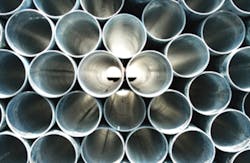Wastewater Infrastructure Upgrades to Boost US Demand for Large-Diameter Pipe
U.S. demand for large diameter pipe is projected to rise 6.2 percent annually through 2016 to 197 million feet due to growth in repair and replacement of wastewater infrastructure, according to a new study by market research firm The Freedonia Group.
The study says many pipe projects, which were put on hold during the 2006-2011 period due to state and municipal budget concerns, will move forward causing an uptick in demand. Additionally, the need to expand oil and gas transmission lines, especially near shale plays and other unconventional wells, will spur growth, and improvement in manufacturing activity will boost pipe demand in processing applications. These and other trends are presented in the new study Large Diameter Pipe.
Steel and high-density polyethylene (HDPE) were the two leading large-diameter pipe materials in 2011, each accounting for 31 percent of total demand, according to the study. Opportunities in the oil and gas industry will spur growth for steel through 2016, as it is the preferred material in both line pipe and oil country tubular goods (OCTG) applications. HDPE will post above average gains as it continues to replace other materials in many applications. For example, corrugated HDPE will continue to replace concrete pipe in many drainage applications, benefiting from its ease of installation and light weight. Concrete will post the most rapid growth through 2016, as the material continues to benefit from its established position in most water markets and its unmatched performance advantages in the largest diameter uses.



